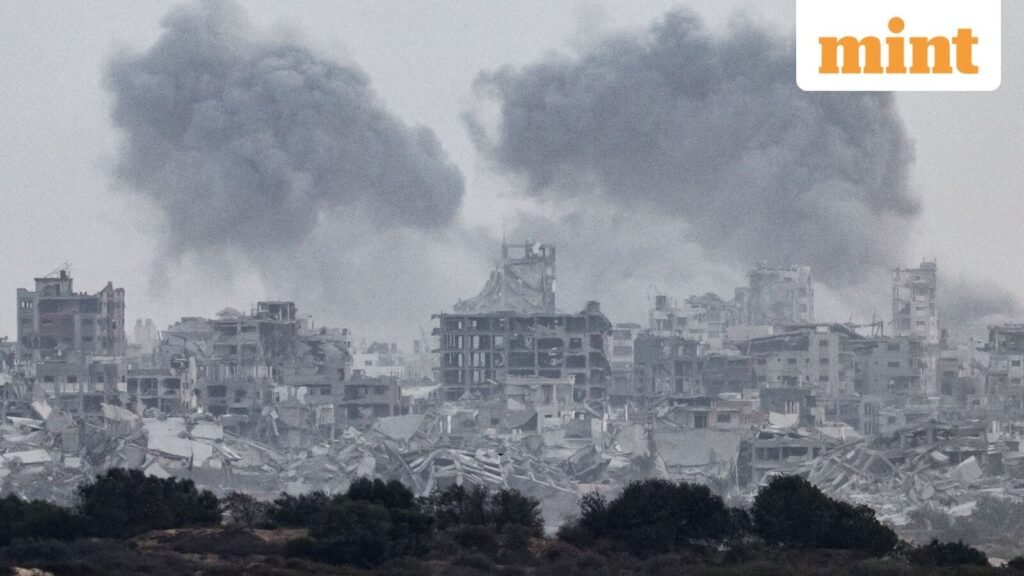In what could be the most significant diplomatic push in years, delegations from Hamas, Israel, and Palestinian factions are set to begin talks in Cairo on Monday, joined by senior US representatives, including Senator Marco Rubio, to negotiate the terms of Donald Trump’s proposed Gaza peace plan.
The move follows Hamas’s partial acceptance of the plan on Friday — a development widely seen as the closest the two sides have come in nearly two years to halting the devastating conflict in Gaza.
The international community has cautiously welcomed the breakthrough, as leaders across the Middle East and beyond express hope that the Trump-led initiative could finally bring an end to a war that has left more than 67,000 Palestinians dead and around 170,000 wounded.
“They have a groundswell of optimism and political momentum behind them,” a senior US official said, noting the rare alignment of interests between Israeli, Palestinian, Arab, and American leaders.
What Did Trump Say in Latest truth Social Post?
A hopeful US President Donald Trump seemed bullish on his proposed peace plan, reiterating it could possibly end ‘centuries old conflict’.
There have been very positive discussions with Hamas, and Countries from all over the World (Arab, Muslim, and everyone else) this weekend, to release the Hostages, end the War in Gaza but, more importantly, finally have long sought PEACE in the Middle East. These talks have been very successful, and proceeding rapidly. The technical teams will again meet Monday, in Egypt, to work through and clarify the final details. I am told that the first phase should be completed this week, and I am asking everyone to MOVE FAST. I will continue to monitor this Centuries old “conflict.” TIME IS OF THE ESSENCE OR, MASSIVE BLOODSHED WILL FOLLOW — SOMETHING THAT NOBODY WANTS TO SEE!
What Does Trump’s Gaza Peace Plan Propose?
The 20-point plan, unveiled last week by the US president, outlines a roadmap to end the war in Gaza. It calls for:
The release of all hostages within 72 hours
- Hamas surrendering power to a transnational authority led by the US president
- Complete disarmament of Hamas
- Gradual withdrawal of Israeli troops from the Gaza Strip
- The release of over 1,000 Palestinian prisoners
- A surge of humanitarian aid and reconstruction funds for Gaza
Trump described the proposal as a “historic opportunity for peace and justice” and has made no secret of his desire to broker the deal before the Nobel Peace Prize is announced on 10 October.
On Saturday night, he posted a map on social media outlining the Israeli withdrawal lines, adding that a ceasefire would begin immediately if Hamas agreed.
What Has Hamas Agreed To?
Hamas has accepted three key components of the Trump plan:
- Releasing all hostages,
- Ceding administrative control of Gaza, and
- Israel’s withdrawal from the territory.
However, the militant group insists that further negotiations are needed on other points, particularly the disarmament clause and a firm timetable for Israeli withdrawal.
Hamas said the rest of the deal “would have to be discussed alongside other Palestinian parties, as it is part of a collective national stance.”
In a statement, the group also emphasised it would accept a Palestinian technocratic government, not the international body proposed by Trump.
Where and When Will Negotiations Between Israel-Hamas-US Take Place?
Delegates from Hamas, Israel, the Palestinian Authority, and the US have arrived in Cairo, with Egyptian intelligence officials mediating the talks. Negotiations are expected to begin on Monday and could yield results within days, according to US and Egyptian sources.
Senator Marco Rubio, representing the US delegation, is expected to play a key role in coordinating between Washington and regional stakeholders.
“A deal to bring Israeli hostages home would ideally happen in the coming days,” said Israeli Prime Minister Benjamin Netanyahu, adding that his government remains “committed to the safe return of every citizen held in Gaza.”
What Are the Remaining Obstacles to Gaza Peace Plan?
Despite growing optimism, significant gaps remain.
Hamas has historically refused to disarm, and there has been no indication that its position has shifted — a sticking point for both Trump and Israel, who insist there will be “no wiggle room” on the matter.
At the same time, Netanyahu has sent mixed signals about Israel’s troop withdrawal.
Shortly after the plan was announced in Washington, the Israeli leader reassured citizens that the IDF would remain in most of Gaza.
On Saturday night, he repeated that message:
“Hostages would be returned while the Israel Defense Forces would remain deep inside the strip.”
This stance contradicts the US plan, which calls for a complete Israeli withdrawal, leaving negotiators with a difficult task — persuading Hamas that any pullout will be genuine and enforceable through international guarantees.
Could Trump’s Gaza Peace Plan Actually Work?
Diplomats describe the Cairo talks as a critical juncture — the first serious attempt in years to end the Gaza conflict.
However, analysts caution that previous negotiations have come close to success only to collapse abruptly, often over the same issues of disarmament, sovereignty, and security guarantees.
“Negotiators will have to bridge these gaps,” one regional analyst told The Guardian, “obtaining clear language from Hamas on disarmament and ensuring Israel’s withdrawal is binding and verified.”
The US administration, keen to showcase diplomatic success ahead of the 2025 election cycle, is likely to exert maximum pressure on both sides. But whether Trump’s peace deal can overcome years of distrust and bloodshed remains uncertain.
As one senior Arab diplomat in Cairo put it: “This may be the best chance yet — but in Gaza, hope has died many times before.”




